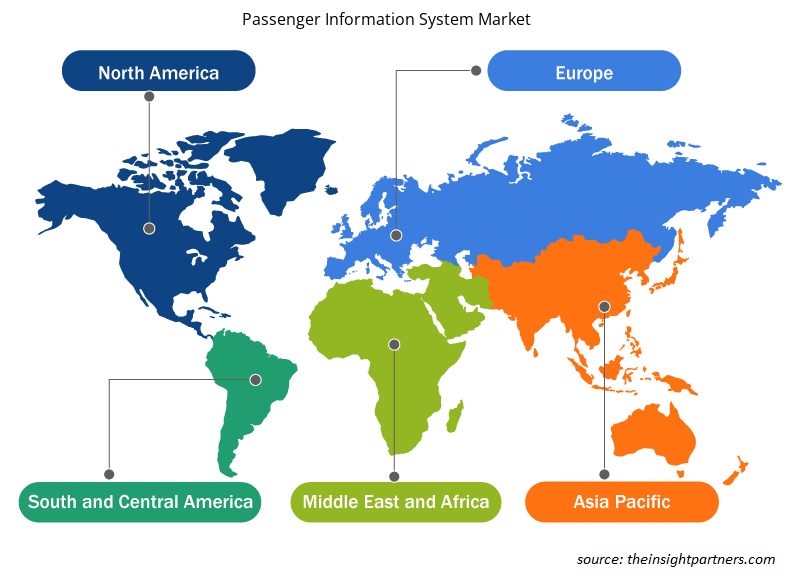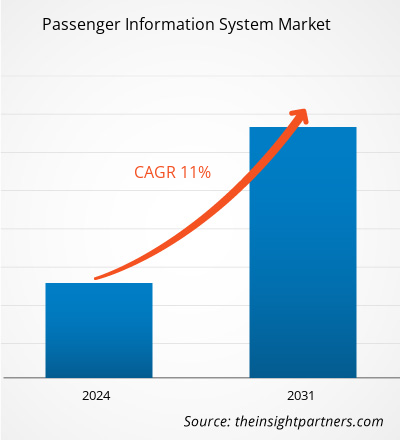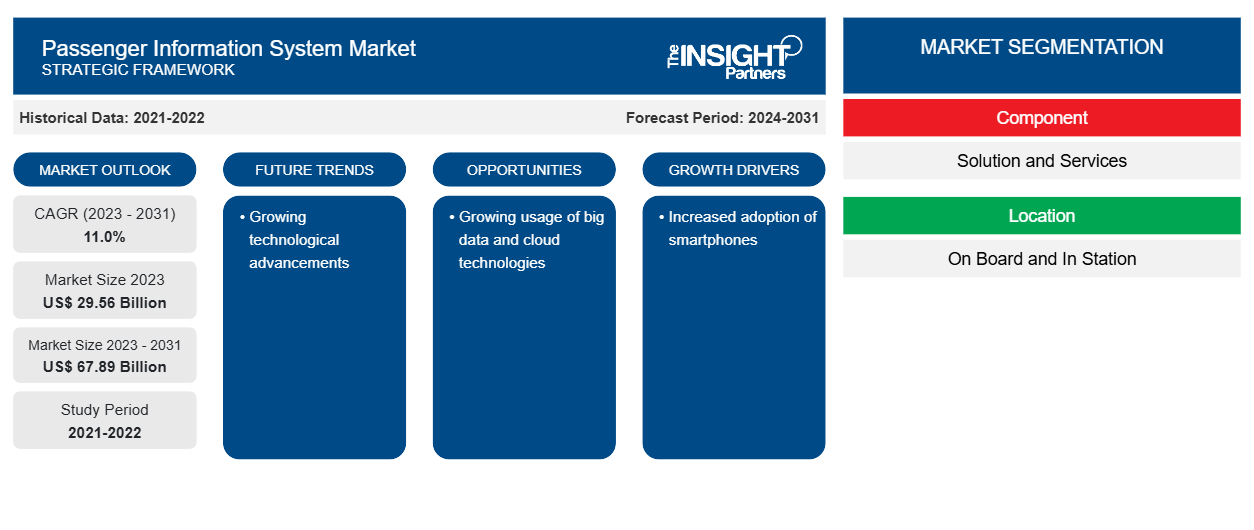Der Markt für Fahrgastinformationssysteme soll von 29,56 Milliarden US-Dollar im Jahr 2023 auf 67,89 Milliarden US-Dollar im Jahr 2031 anwachsen. Der Markt wird voraussichtlich zwischen 2023 und 2031 eine durchschnittliche jährliche Wachstumsrate (CAGR) von 11,0 % verzeichnen. Wachsende technologische Fortschritte werden wahrscheinlich weiterhin die wichtigsten Trends auf dem Markt für Fahrgastinformationssysteme bleiben.
Marktanalyse für Passagierinformationssysteme
Die Nachfrage nach Fahrgastinformationssystemen ist aufgrund mehrerer Faktoren gestiegen, darunter eine Zunahme des Flugverkehrs, eine zunehmende Einführung intelligenter Transportsysteme, eine zunehmende Verbreitung von IoT-Lösungen im Transportsektor und eine steigende Nachfrage der Passagiere nach Echtzeit-Transitinformationen. Darüber hinaus wird erwartet, dass der Markt für Fahrgastinformationssysteme von der steigenden Nachfrage nach allen reisebezogenen Informationen profitiert, von Reiseplanern bis hin zu Änderungen der voraussichtlichen Abfahrtszeiten. Darüber hinaus wird erwartet, dass das gestiegene Bewusstsein der Verkehrsbetriebe, ihren Kunden ein verbessertes Reiseerlebnis zu bieten, die Marktexpansion vorantreiben wird.
Marktübersicht für Passagierinformationssysteme
Der Zweck eines Fahrgastinformationssystems besteht darin, Fahrgästen über Audio- , Video- und Mediengeräte aktuelle Informationen über den Zustand und die Art der Transportdienste zu geben. Es besteht aus einer Sammlung von Hardware- und IT-Komponenten. Es bietet auch Nachrichten- und Unterhaltungsdienste sowie Angaben zu den voraussichtlichen Ankunfts- und Abfahrtszeiten, die alle zu einem verbesserten Reiseerlebnis beitragen. Der Markt für Fahrgastinformationssysteme wächst aufgrund des wachsenden Bedarfs der Verkehrsbetriebe, Fahrgäste mit genauen und zuverlässigen Echtzeit-Transitinformationen zu versorgen. Darüber hinaus wächst der Markt aufgrund von Entwicklungen in der Telekommunikationsbranche, die schnellere Datenübertragungsmöglichkeiten ermöglichen, einem Anstieg der Einführung von IoT im Transportsektor und einer steigenden Nachfrage nach intelligenten Transportsystemen.
Passen Sie diesen Bericht Ihren Anforderungen an
Sie erhalten kostenlos individuelle Anpassungen an jedem Bericht, einschließlich Teilen dieses Berichts oder einer Analyse auf Länderebene, eines Excel-Datenpakets sowie tolle Angebote und Rabatte für Start-ups und Universitäten.
-
Holen Sie sich die wichtigsten Markttrends aus diesem Bericht.Dieses KOSTENLOSE Beispiel umfasst eine Datenanalyse von Markttrends bis hin zu Schätzungen und Prognosen.
Markttreiber und Chancen für Passagierinformationssysteme
Zunehmende Nutzung von Smartphones
Da die Smartphone-Nutzung zunimmt, erfreuen sich Fahrgastinformationssysteme auf Basis mobiler Anwendungen zunehmender Beliebtheit. Darüber hinaus konzentrieren sich Verkehrsbetriebe auf mobile Anwendungen für Fahrgastinformationssysteme, um Kunden anzulocken und ihnen über Smartphone-Kanäle Zugang zu schnellen, genauen Informationen in Echtzeit zu verschaffen. Auch der Aufstieg multimodaler Transitanwendungen für den öffentlichen Nahverkehr bietet eine Chance zur Markterweiterung.
Zunehmende Nutzung von Big Data und Cloud-Technologien
Insbesondere Eisenbahnen nutzen Cloud Computing, um viele Transportmittel zu automatisieren. Mithilfe von Cloud Computing-Technologie verfolgt das Fahrgastinformationssystem den Aufenthaltsort von Bussen in der Nähe. Es ermittelt die Ankunftszeit, die dann im Echtzeit-Informationssystem an der Bushaltestelle angezeigt wird. Die Nutzung von Cloud-Technologie und Datenanalyselösungen trägt zu einer effizienten Ressourcenzuweisung und einer wirtschaftlichen Überwachung der Fahrgastzahlen bei.
Segmentierungsanalyse des Marktberichts für Passagierinformationssysteme
Wichtige Segmente, die zur Ableitung der Marktanalyse für Fahrgastinformationssysteme beigetragen haben, sind Komponente, Standort, Transportart und Funktionsmodell.
- Basierend auf den Komponenten ist der Markt für Fahrgastinformationssysteme in Lösungen und Dienste unterteilt. Das Lösungssegment hatte im Jahr 2023 einen größeren Marktanteil.
- Nach Standort ist der Markt in On-Board und In-Station segmentiert. Das On-Board-Segment hielt im Jahr 2023 den größten Marktanteil.
- In Bezug auf die Transportmittel ist der Markt in Straßen, Eisenbahnen, Wasserstraßen und Luftwege unterteilt. Das Straßensegment dominierte den Markt im Jahr 2023.
- Nach Funktionsmodell ist der Markt in Multimedia-Displays, Audiosysteme, Computersysteme, Netzwerk- und Kommunikationsgeräte, Videoüberwachung und Content-Management-Systeme segmentiert.
Marktanteilsanalyse für Passagierinformationssysteme nach Geografie
Der geografische Umfang des Marktberichts zum Fahrgastinformationssystem ist hauptsächlich in fünf Regionen unterteilt: Nordamerika, Asien-Pazifik, Europa, Naher Osten und Afrika sowie Südamerika/Süd- und Mittelamerika. Nordamerika kontrollierte den globalen Markt für Fahrgastinformationssysteme. Darüber hinaus wird der nordamerikanische Markt im Prognosezeitraum wahrscheinlich stark wachsen. Der Hauptfaktor für die Marktexpansion in diesem Bereich ist die Zunahme sowohl der Produktion als auch des Verbrauchs von Fahrgastinformationssystemen in den Industrie- und Entwicklungsländern Nordamerikas. Das PIS gilt als einer der größten Märkte mit einer besonders hohen Nutzung modernster Technologie und einer robusten Netzwerkinfrastruktur. Die Region hat einen erheblichen Einfluss auf die Expansion des Marktes für Fahrgastinformationssysteme aufgrund von Elementen wie der zunehmenden Nutzung des öffentlichen Nahverkehrs und der schnellen Urbanisierung. Darüber hinaus wird erwartet, dass die zunehmende Nutzung von Diensten und Lösungen für Fahrgastinformationssysteme die Expansion fördern wird. All diese Faktoren tragen zum Wachstum des Marktes für Fahrgastinformationssysteme in der Region bei.
Regionale Einblicke in den Markt für Passagierinformationssysteme
Die regionalen Trends und Faktoren, die den Markt für Passagierinformationssysteme im gesamten Prognosezeitraum beeinflussen, wurden von den Analysten von Insight Partners ausführlich erläutert. In diesem Abschnitt werden auch Marktsegmente und Geografie für Passagierinformationssysteme in Nordamerika, Europa, im asiatisch-pazifischen Raum, im Nahen Osten und Afrika sowie in Süd- und Mittelamerika erörtert.

- Erhalten Sie regionale Daten zum Markt für Passagierinformationssysteme
Umfang des Marktberichts zum Passagierinformationssystem
| Berichtsattribut | Details |
|---|---|
| Marktgröße im Jahr 2023 | 29,56 Milliarden US-Dollar |
| Marktgröße bis 2031 | 67,89 Milliarden US-Dollar |
| Globale CAGR (2023 - 2031) | 11,0 % |
| Historische Daten | 2021-2022 |
| Prognosezeitraum | 2024–2031 |
| Abgedeckte Segmente |
Nach Komponente
|
| Abgedeckte Regionen und Länder |
Nordamerika
|
| Marktführer und wichtige Unternehmensprofile |
|
Marktteilnehmerdichte: Der Einfluss auf die Geschäftsdynamik
Der Markt für Passagierinformationssysteme wächst rasant, angetrieben durch die steigende Nachfrage der Endnutzer aufgrund von Faktoren wie sich entwickelnden Verbraucherpräferenzen, technologischen Fortschritten und einem größeren Bewusstsein für die Vorteile des Produkts. Mit steigender Nachfrage erweitern Unternehmen ihr Angebot, entwickeln Innovationen, um die Bedürfnisse der Verbraucher zu erfüllen, und nutzen neue Trends, was das Marktwachstum weiter ankurbelt.
Die Marktteilnehmerdichte bezieht sich auf die Verteilung der Firmen oder Unternehmen, die in einem bestimmten Markt oder einer bestimmten Branche tätig sind. Sie gibt an, wie viele Wettbewerber (Marktteilnehmer) in einem bestimmten Marktraum im Verhältnis zu seiner Größe oder seinem gesamten Marktwert präsent sind.
Die wichtigsten auf dem Markt für Passagierinformationssysteme tätigen Unternehmen sind:
- TELESTE CORPORATION
- SIEMENS AG
- THALES-GRUPPE
- CUBI CORPORATION
- INDRA SISTEMAS SA
- ALSTOM
Haftungsausschluss : Die oben aufgeführten Unternehmen sind nicht in einer bestimmten Reihenfolge aufgeführt.

- Überblick über die wichtigsten Akteure auf dem Markt für Passagierinformationssysteme
Marktnachrichten und aktuelle Entwicklungen zum Passagierinformationssystem
Der Markt für Fahrgastinformationssysteme wird durch die Erhebung qualitativer und quantitativer Daten nach Primär- und Sekundärforschung bewertet, die wichtige Unternehmensveröffentlichungen, Verbandsdaten und Datenbanken umfasst. Im Folgenden finden Sie eine Liste der Entwicklungen auf dem Markt:
- Im Januar 2021 führte Cubic Corporation zur Erweiterung seines aktuellen Transporttechnologieportfolios die vollständig integrierte Plattformsuite „UMO“ für Mobilität, Fahrgäste, Dienstleister und Verkehrsbehörden ein. UMO ist eine flexible Suite von Tools, mit denen Benutzer Fahrten mit öffentlichen und privaten Verkehrsmitteln planen, bezahlen, Prämien für Fahrten erhalten und aktuelle Informationen zur Steigerung ihrer Mobilität erhalten können.
(Quelle: Cubic Corporation, Unternehmenswebsite)
- Im Juni 2020 wurde das Luftfiltergerät „BlueFiIter“ von der Wabtec Corporation eingeführt, um Fahrgästen in Zügen und U-Bahnen eine saubere, gesunde Umgebung zu bieten. In Waggons beseitigt BlueFilter über 90 % der Schadstoffe.
(Quelle: Wabtec Corporation, Unternehmenswebsite)
Marktbericht zum Passagierinformationssystem – Umfang und Ergebnisse
Der Bericht „Marktgröße und Prognose für Passagierinformationssysteme (2021–2031)“ bietet eine detaillierte Analyse des Marktes, die die folgenden Bereiche abdeckt:
- Marktgröße und Prognose auf globaler, regionaler und Länderebene für alle wichtigen Marktsegmente, die im Rahmen des Projekts abgedeckt sind
- Marktdynamik wie Treiber, Beschränkungen und wichtige Chancen
- Wichtige Zukunftstrends
- Detaillierte PEST/Porters Five Forces- und SWOT-Analyse
- Globale und regionale Marktanalyse mit wichtigen Markttrends, wichtigen Akteuren, Vorschriften und aktuellen Marktentwicklungen
- Branchenlandschaft und Wettbewerbsanalyse, einschließlich Marktkonzentration, Heatmap-Analyse, prominenten Akteuren und aktuellen Entwicklungen
- Detaillierte Firmenprofile
- Historische Analyse (2 Jahre), Basisjahr, Prognose (7 Jahre) mit CAGR
- PEST- und SWOT-Analyse
- Marktgröße Wert/Volumen – Global, Regional, Land
- Branchen- und Wettbewerbslandschaft
- Excel-Datensatz
Aktuelle Berichte
Erfahrungsberichte
Grund zum Kauf
- Fundierte Entscheidungsfindung
- Marktdynamik verstehen
- Wettbewerbsanalyse
- Kundeneinblicke
- Marktprognosen
- Risikominimierung
- Strategische Planung
- Investitionsbegründung
- Identifizierung neuer Märkte
- Verbesserung von Marketingstrategien
- Steigerung der Betriebseffizienz
- Anpassung an regulatorische Trends























 Kostenlose Probe anfordern für - Markt für Passagierinformationssysteme
Kostenlose Probe anfordern für - Markt für Passagierinformationssysteme